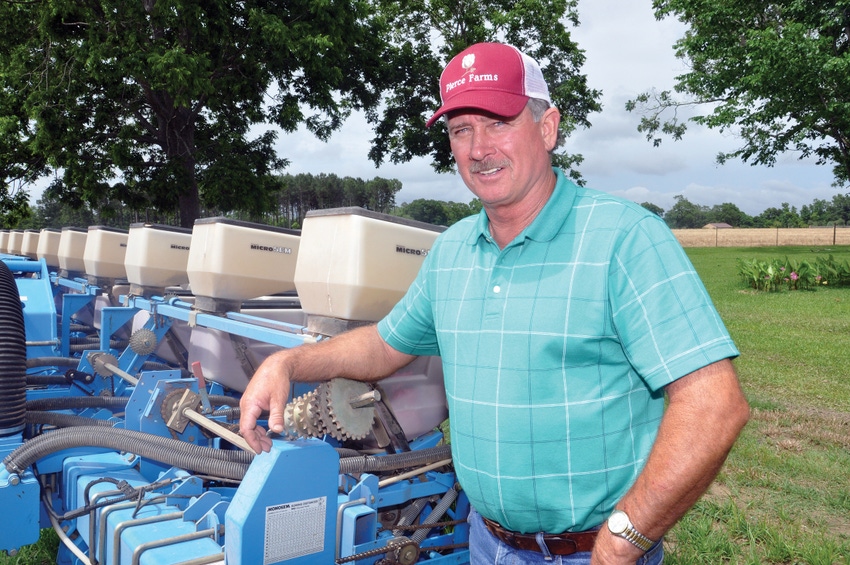
It’s late May and Agricola, Miss., farmer Hugh Pierce needs to be on the planter. But heavy and frequent rains along the Mississippi Gulf Coast this spring have made this planting season very much a stop-and-go operation.
So Pierce walks off the nervous energy around the shop and office, located just off Hwy. 612, in George County, chatting up his secretary, Wendy Danley, teasing his labor force, keeping up a good front, even as another band of thunderstorms rolls in from the west.
Pierce knows bad weather comes with the job, but it’s not the frequency of rain this spring that concerns him, it’s the rate at which it’s been falling. In late April, the nearby Mobile Regional Airport reported 11 inches in one day. Some areas reported as much as 5 inches falling in one hour.
Stay current on what’s happening in Mid-South agriculture: Subscribe to Delta Farm Press Daily.
“It’s been a nightmare,” Pierce said. “About the time we get dried out and going good, here comes another monsoon. We haven’t been getting showers. We’ve been getting floods. Ten inches of rain isn’t anything anymore. We haven’t had to replant anything yet, and everything we’ve planted is up. But we’re behind.”
2,700 acres of peanuts
Pierce farms in six counties in Alabama and Mississippi, producing about 2,000 acres of cotton, 2,700 acres of peanuts, 1,300 acres of wheat, 200 acres of oats for grazing around 1,100 calves and 170 acres of watermelons.
He farms about 40 miles north of the Mississippi Gulf Coast, where the sandy loam soil and sub-tropical climate is perfectly suited for peanuts. Grown in this region since around 2003, peanuts are the money-making partner in Pierce’s peanut-cotton rotation program, thanks to yields that can approach 2.5 tons per acre.
For peanuts following cotton, Pierce will burn down with Roundup and Valor in February. He’ll disk twice, one of those times to incorporate lime and fertilizer (300 pounds of 9-23-30, which is primarily a benefit for the following cotton crop), run an Orthman,12-row strip-till and plant peanuts in twin-rows on 36-inch rows, along with an inoculant.
Twin row yield benefits
He plants with two Monosem planters, a 6-row and a 12-row. According to research at the University of Georgia, twin-row peanuts can increase peanut yield by 300 pounds to 400 pounds per acre. “I’m not sure about the higher yields, but the twin rows lap the middles so quick, so it helps with weed control,” Pierce said.
His primary peanut variety is Georgia 06G, a high-yielding, tomato spotted wilt virus resistant, large-seeded runner-type peanut variety that was released in 2006 by the Georgia Agricultural Experiment Stations.
As soon as peanuts are planted, Pierce will apply Valor and Roundup. “The peanuts come up clean and they’re easy to keep clean. The Valor has some residual that keeps weeds down until we make an application of Cadre and 2,4-D or Strongarm about 30 days after planting.”
When the time comes to make a fungicide application on his peanuts, Pierce would much rather be early than late. If it’s likely that a weather front will be coming through when a spray is scheduled, he’ll get to the field right away, rather than wait. “Timing is everything in peanuts,” Pierce said.
The first fungicide treatment is typically made 45 days after emergence, and every two weeks after that until peanuts are out of danger, primarily from leaf spot and white mold. He’ll alternate fungicides Tilt, Bravo, Convoy and Initiate and will piggyback a micronutrient, boron, and Holster for stink bugs. The applications are made with a John Deere 4730 or John Deere 6700.
Disease and rotation
When cotton prices were high several years ago, Pierce went with two years of cotton and one year of peanuts. With cotton prices falling, he’s gone to a 1-1 peanut/cotton rotation, and hasn’t seen a drop off in yield due to disease yet.
“It may catch up with us down the road. But you can’t make money growing 80-cent cotton at 900 pounds to 1,000 pounds per acre. Our money is in peanuts. I’ve paid for things I didn’t think I could ever pay for with peanuts. Peanuts have been good to us. They’re our bread and butter.”
At harvest, Pierce runs three, 6-row KMC peanut diggers, four, pull-type Amadas combines and one self-propelled Amadas. Peanuts are hauled to West Bay Peanut in Wilmer, Ala., or Birdsong in Atmore, Ala.
Typically, Pierce’s peanut yields average 2.5 ton per acre. “Last year, our yields were a little over 4,800 pounds. The first seven years we grew peanuts in Stone County, Miss., we had one 540-acre field where we averaged 6,300 pounds.”
Virgin land
Pierce attributes good peanut yields and quality to virgin land, ample rainfall, a long, warm growing season, a strict fungicide program, the peanut plant’s ability to bounce back from stresses and his soil type. “The sandier the soil, the better the peanuts, as long as they get the water. They dig clean and go in the trailers clean. We don’t have a dirt problem at all.”
Pierce gets a lot of his information on peanut production from John Beasley, former Extension peanut agronomist at the University of Georgia, now at Auburn University and Marshall Lamb, with USDA’s Agricultural Research Service, in Dawson Ga., who provides marketing advice.
As of late May, Pierce had about 1,700 acres of peanuts and 800 acres of cotton planted, with 1,000 acres of peanuts and 1,200 acres of cotton left to go. Pierce knows that sooner or later, the rain will break long enough to harvest his wheat, which is ready to go, and finish up with cotton and peanuts. But no doubt, as the calendar is turning to June, Pierce is ready to burn some diesel.
About the Author(s)
You May Also Like






